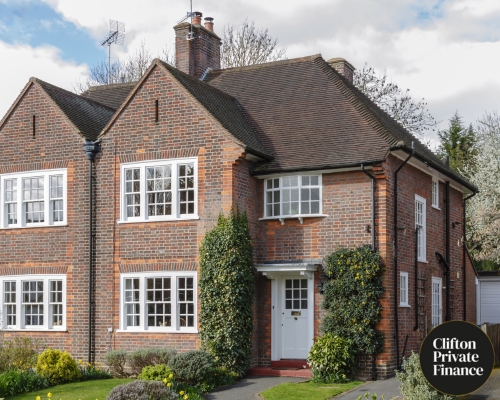Categories
Can I Get A Bridging Loan To Pay Inheritance Tax?
.jpg)
Yes - it's common to use bridging finance to pay inheritance tax before it is due. In fact, using short-term finance can be a convenient means to handle some of the administrative issues that make managing probate so difficult.
One of the common issues that can arise during this process is that the inheritance tax bill is typically due before the estate is yours. This means it's not unheard of for benefactors to receive a large tax bill for an asset they don't yet own and therefore can't use to pay the bill.
It's a frustrating catch-22 that can be solved reasonably easily with a flexible short-term finance solution such as a bridging loan.
Why would someone use a bridging loan to pay inheritance tax?
Inheritance tax is imposed on the estate (the total value of the assets) of a person who has passed away. It is a form of taxation that occurs upon the transfer of assets from a deceased individual to their heirs or beneficiaries.
You can’t use assets from the estate to pay the tax
- HMRC requires payment of IHT at the end of the sixth month after someone’s death.
- But they will only grant probate (access to the assets of the estate) after they have received the tax they’re owed.
You can understand why. The beneficiaries might use their windfall to pay the school fees, start work on the loft extension, or buy a holiday home before they get around to paying the taxes.
However, it means the executors can’t use the proceeds from selling the assets of the estate to pay the IHT.
In some cases, this means finding the funds to pay the bill quickly, and a bridging loan can be a convenient option for this purpose.
Written by: Sam O'Neill & Sam Hodgson
In this blog:
Probate loans vs bridging loans
What can you use as security for a bridging loan?
Who will give you a bridging loan?
Why else would you want a bridging loan to settle an estate?
How much is inheritance tax?
- In the UK, a deceased estate must pay inheritance tax at 40% on everything above £325,000 (the individual allowance for one person).
- The allowance is twice this amount for a married couple, payable after the second spouse dies.
- Beneficiaries don’t pay IHT on their inheritance, but they may need to pay income or capital gains tax later.
How can you pay?
- If there’s enough cash in the estate, an executor can arrange for a direct payment to transfer the money owed straight from the bank where it’s held to the HMRC, bypassing the beneficiaries.
- If there isn’t enough cash available, the executors can put up the money for the tax bill out of their own pockets.
- Or there are two types of loans available: a probate loan (also known as an executor loan) or a bridging loan.

Probate loans vs bridging loans
Probate loans, also known as executor loans, can be arranged quickly and are secured against the value of your inheritance.
A bridging loan, on the other hand, is secured against the personal property of the executor of the estate.
Probate loans are good because you have no personal liability for the loan repayments - it is automatically deducted from the estate when the Grant of Probate is completed. And if any assets have lost value, the lender loses out, not you.
However, they end up having higher interest rates compared to bridging loans. Bridging loans are good because they're generally a cheaper option. However, they come at a larger risk to the borrower in that they need to use their property as collateral for the loan.
If the assets in the estate don't cover the repayment of the bridging loan, your lender has the right to sell your property to recoup their debt.
While this may sound intimidating, it is common practice among property loans - mortgages, for example, are always secured with collateral.
If you're unsure which option is right for you, we recommend booking in with a specialist adviser who can look at your finances at a wider level and walk you through the pros and cons and process for each option.
We also have a full guide to bridging loans and a full guide to probate loans.
What is a bridging loan?
In the video below, our head of Bridging, Sam O'Neill, goes over the basics of bridging finance and its uses:

Sam O'Neill
Head of Bridging
Let us do all the hard work of finding the right bridging lender for your circumstances.
We secure bridging finance for applications of all types, and we negotiate competitive lending to meet your needs and timescale.
What can you use as security for a bridging loan?
You can’t borrow against the property in the estate you’re due to inherit – because you don’t own it yet. You’re not legally entitled to sign any papers against the property, and a lender wouldn’t have any security for their lending.
- You can use another property you own as security. This can act as your bridging loan deposit.
- The property in the estate can be used as your exit from the bridge finance (your means of repaying the loan) if you intend to sell it.
- Your exit strategy must be agreed upon with a lender before they will pay out funds, and it needs to be achievable within the usual 12-month maximum term of a regulated bridging loan. (It may be possible to arrange an extension of the loan term if, for example, a sale is agreed upon for the inherited property but has yet to be completed.)
- The lender will need to feel confident that the estate is relatively uncomplicated and the will won’t be contested.
In very rare circumstances, a specialist bridging lender may be able to secure finance against a property still held within the estate. However, it's a rare occurrence and very difficult.
Who will give you a bridging loan?
Lenders are well-used to offering short-term finance to pay for inheritance taxes.
The assets which can be used to repay the loan can usually be clearly identified, having been valued for probate. Our brokers at Clifton Private Finance can introduce you to lenders who will offer you terms that suit the structure of the estate’s assets.
Why else would you want a bridging loan to settle an estate?
Families and family assets are seldom straightforward, and emotions run high when people are grieving.
Having access to short-term finance can take the heat out of a situation which could otherwise cause conflict:
- Retaining ownership of a family home: It’s not unusual for three siblings, say, to jointly inherit a family home that one of them wants to live in. In which case, there will be a delay in dividing up the assets until market valuations are agreed and a mortgage is arranged to buy out the other two siblings.
- Shares in a family business: There may a family business that need to be valued and, again, one of the beneficiaries may be directly involved in running the company, or want to acquire a controlling share.
- Need for early payment: It's quite common for one or more of the beneficiaries to have a more pressing need for a payout and be pushing to realise assets sooner than their full market value can be achieved.
Organising short-term finance until the estate is settled can avoid a fire-sale of assets and allow important financial decisions to be made in a measured way that will reduce family conflict. For an indicative quote, use our bridging loan calculator.
Clifton Private Finance can arrange estate finance for you
We have experienced advisors who specialise in arranging quick, short-term finance for situations exactly like this.
Bridging loan advice gives you the peace of mind you're making the right decision for your situation.
Our advisers will listen to the details of your situation and propose the best financial solution. Call us to arrange a convenient time to talk through the details and check you fit the criteria for a bridging loan.
0117 959 5094
FAQs
Yes, a valuation is typically required for a bridging loan in the UK. Since bridging loans are often secured against a property or other valuable assets, lenders will want to assess the market value of the property being used as security. This helps the lender determine how much deposit they want you to provide based on the value and condition of the property. You can borrow up to £25m with bridging finance, but it’s typically capped at about 80% of the value of the property you’re using as security. It's important to note that different lenders have varying policies and criteria regarding the maximum loan amounts they offer for bridging finance. Some lenders have a maximum limit of over £1 million, while others may specialize in smaller loan amounts. Additionally, the terms and conditions of the loan, including interest rates and fees, should also be taken into consideration when determining the overall affordability of the bridging loan. Yes, you typically need a 20-40% deposit for a bridging loan. It can be possible to get a bridging loan without a deposit (a 100% bridging loan), but you’ll need other assets in the background to secure the loan against, and more stringent criteria and higher costs could apply. Yes, it is possible to get a 100% bridging loan (also known as a 100% LTV bridging loan), but it is rare. This means that you won’t need to put down a deposit and can borrow the full value of your property. However, the criteria for these loans can be hard to meet, and you’ll need to provide additional assets as security for your loan. Interest rates and fees can also be higher to compensate. While using bridging finance doesn’t technically make you a cash-buyer, it can allow you to act like one. Mortgages take months to process, often leading to an ‘onward chain’ where all parties involved need to wait for funds to be transferred. Bridging finance can usually be accessed a lot quicker than mortgages so you can bypass the onward chain, giving you an advantage over other buyers and being attractive to sellers. Bridging loans typically have a term of 12 months, but some lenders are willing to stretch their terms to 18 months, or even 2 –3 years depending on the case. Terms longer than 2 years will usually only be considered for specific cases. Yes, you can use a bridging loan to pay Stamp Duty. This amount could be covered by a bridging loan, providing you have a way to repay the additional borrowing amount to your lender. Yes, bridging loans are safe when they’re used in the right circumstances with a solid repayment strategy. However, we recommend speaking to a qualified advisor, like our brokers at Clifton Private Finance, before you take out a product. The main factors to consider with bridging finance are that the full loan amount will usually need to be repaid within a year, and like a mortgage, it is secured against a property as collateral. This means that in the case that you aren’t able to repay your bridging loan, your property would be at risk of repossession. But with a watertight exit strategy, bridging finance can be an efficient way to secure property quickly. Bridging loans are designed to be short-term so there’s no maximum age limit when applying for a bridging loan. This does depend on the lender, as some bridging lenders do have an upper age limit, but there are lenders on the market who offer bridging loans for borrowers aged 70 and over. Bridging loan interest rates usually range between 0.45% - 2% per month, depending on the case and the market rate. Unlike mortgage interest rates, bridging loan interest is calculated monthly instead of yearly. This is because bridging loans are short-term and, in many cases, repaid within a year. Bridging loans can be arranged without early repayment penalties, so interest is calculated monthly to ensure you only pay interest on the months you have the loan for. Unfortunately, mainstream banks in the UK don’t offer bridging loans. This means that if you’re looking for a bridging loan, you won’t be able to get one using a lender you’d find on the high street. There are a variety of specialist lenders that offer bridging loans, but because these lenders are smaller and more niche, you may need a bridging broker to access them. Banks typically charge two main fees when taking out a bridging loan – arrangement fees and interest. But there are other costs to consider such as valuation fees, broker fees and administration fees. Costs can vary from lender to lender, and will also depend on what your bridging loan is for (e.g., residential or commercial purposes.) Arrangement fees are what the lender charges you to take out the loan and can range between 1.5 - 3% of your overall loan. Bridging loan interest, on the other hand, is calculated monthly. This can catch borrowers out who may be expecting an Annual Percentage Rate (APR) like with a mortgage. Yes, you can convert a bridging loan to a mortgage through refinancing, and it is common among borrowers who use bridging finance to buy residential properties. However, whether or not you’ll be able to refinance to a mortgage is dependent on your financial circumstances, the lender, and the property you’re planning to buy. It’s important to be sure that refinancing is a viable repayment option before you take out a bridging loan on a residential property. Yes, bridging loans are typically more expensive than mortgages. Bridging loan interest rates can be much higher than a mortgage, and are calculated and displayed as monthly rates instead of the usual annual percentage rate (APR) that you’ll see on a mortgage. However, bridging loans are a short-term solution, and you’ll only pay interest on the months you’ve borrowed money for – and you can repay early without any charges (for most loans). There are many circumstances where bridging loans are an affordable option and a means to an end - for borrowers that need to finance a property purchase quickly, it may be the only option available. The two most common ways to pay a bridging loan are to sell a property or refinance to a mortgage. You may also need to ‘service’ the loan through the term, which means paying the interest monthly. However, you can opt to ‘roll up’ your bridging interest to be repaid at the end along with the capital. There are also other ways to repay a bridging loan, such as selling a business or even using money from an inheritance. The method in which you pay your bridging loan can be flexible, just as long as it is clear in your application that you have a surefire way to repay your loan when the terms are up. In most cases, a bridging loan will require a minimum deposit of 25%. However, the minimum can vary depending on the lender and the specific circumstances of the loan itself. Generally, bridging loans are secured against a property or other valuable assets, and the deposit required is often expressed as a percentage of the property's value, known as the loan-to-value ratio. In some cases, 0% deposit bridging loans are an option, but only if you have other property or assets in the background to provide additional security. No, typically, you’ll repay a bridging loan in one chunk at the end of the loan term. Bridging loans are a form of short-term finance and will usually need to be repaid within 12 months, but there can be room for flexibility. In some cases, borrowers may be required to make monthly interest payments. This means that each month, you would pay the interest accrued on the loan amount while the principal amount remains outstanding until the end of the loan term. But usually, the interest is "rolled up" or added to the loan balance and paid with the rest of the loan at the end of the term. This option can help protect your cashflow so you can spend it on moving costs or refurbishments, for example. Bridging loans can be arranged in as little as 7 working days. However, it depends on the complexity of the bridge loan and your specific circumstances. It may also be more expensive for you to rush an urgent application through – but not impossible. Bridging loans are a popular option for borrowers who are under time constraints, such as buying a property at auction or breaking a chain. The key factors lenders tend to consider are: Security - Bridging finance is usually secured against property or other valuable assets. Lenders will assess the value and marketability of your security. Exit Strategy - Lenders will want to understand how you plan to repay your bridging loan. In most cases, this is selling your old property, selling the new property (flipping), or refinancing with a long-term mortgage. Loan-to-Value (LTV) Ratio - Lenders consider the loan amount compared to the value of the property being used as security as a percentage. The LTV ratio can vary, but most lenders will have a maximum of 60-80% LTV. Remember, the criteria for obtaining bridging finance in the UK can vary depending on the lender and your circumstances.
Do you need a valuation for a bridging loan?
How much can you borrow with bridging finance?
Do you need a deposit for a bridging loan?
Can I get 100% bridging finance?
Does a bridging loan make you a cash buyer?
What is the longest bridging loan term?
Can I use a bridging loan to pay stamp duty?
Are bridging loans safe?
Can an 80 year old get a bridging loan?
What is the monthly interest rate on a bridging loan?
Do banks still do bridging loans?
How much do banks charge for bridging loans?
Can you turn a bridging loan into a mortgage?
Is a bridging loan more expensive than a mortgage?
How are bridging loans paid?
What is the minimum deposit for a bridging loan?
Do you pay monthly payments on a bridging loan?
How long does it take for a bridging loan to come through?
What is the criteria for bridging finance?









.png)

